The debut for this seasonal look-see is Barbados Cherry (Malpighia glabra). I love Barbados Cherry, but even I don’t think it’s a particularly sexy, exciting plant. It’s rather a staple of sorts: the practical “nursing shoe” of plants versus its sexier “stiletto heel” exhibitionist kin. Barbados Cherry is tough, reliable and in its steady way, beautiful. Gardeners utilize it as a hedge, but it also produces a mass of blooms, at least a couple of times per year, with lush berries following. It is extremely drought tolerant, growing well in shade, part shade and full sun. Barbados Cherry is an excellent wildlife plant. It develops into a thick shrub/thicket, so birds love it for protection and is a host/nectar plant for several butterflies. For all that acclaim, Barbados Cherry is not a particularly fast grower and is not deer resistant.
Most of the year, Barbados Cherry presents as a green shrub, though individual plants can be shaped as a sphere or in tree form. I don’t care for overly pruned plants, preferring more natural growth patterns. I’ve only pruned my B. Cherry to prevent overhanging the driveway too much. I planted my original five shrubs about 20 years ago, in a shade/part shade area, primarily as a privacy hedge. Once established, B. Cherry like this most of the year.
A disclaimer: these photos were taken in autumn, but Barbados Cherry are green, rear-round, with some exceptions, noted later.
The photos illustrate a plant, while not heart-stopping, is green, lush and tough. In the course of its life, my hedge of Barbados Cherry withstood bicycles, basketballs, soccer balls and all manner of kid destruction while demanding nothing from me, serving its purpose well.
In spring and fall, reliably after rain, the Barbados Cherry will explode with ruffly clusters of pink, dainty flowers.
My experience is that the bloom cycle lasts up to about six weeks, once in the spring/early summer and then again in the fall.
During the bloom cycle, berries like this beauty develop.
Barbados Cherry is especially stunning when there are blooms and berries at the same time which typically occurs during both bloom cycles..
Many birds, but especially mockingbirds, favor the berries. The berries are sweet, though a little seedy for my taste.
Depending upon the winter, Barbados Cherry exhibits differing responses. To about 30 degrees for short periods of time, Barbados Cherry remains evergreen. If temperatures remain in the low 30s for long periods or dip into the 20s, for more than 12-15 hours, some of the upper limbs will defoliate, though in a thick bramble, the rest will likely stay green.
Not much green here, because of the freeze events of the 2013-14 winter. Still, this group (different from the one in the photos above) isn’t completely frozen to the ground because it’s in a protected area. The branches will flush out with new growth once temperatures warm. There’s no need to prune further than where you can scratch the surface to find some green. In this photo, it’s just below the copyright.
Because winter was colder than in the last 2 decades and the original, exposed stand of Barbados Cherry experienced a number of freezes well into the mid 20s, they froze completely to the ground.
I knew they were goners when I saw the trunks of the shrubs.
By early March, I’d cut all of the original stand of Barbados Cherry to the ground.
So much for my privacy hedge! Now, to wait until new growth from the roots. Finally, in late March, signs of life!!
As of the end of March 2014, these individual plants are recovering slowly from the hard freezes of this past winter.
In fact, B. Cherry is at its northern range in Austin. According to the Native Plant Database of the Lady Bird Johnson National Wildflower Center, B. Cherry are native to South Texas, Mexico and into Central and South America. So it is a tropical plant and not reliably evergreen in Austin. I knew that when I planted, but was lulled to complacency by the abnormally mild winters we’ve experienced since the mid-to-late 1990s. As of March 31, 2014 all of the Barbados Cherry are sprouting green from the trunks. I’ll definitely keep them, but because the light requirements have changed for this garden, I am augmenting the garden by planting other native plants and will prune the B. Cherry more regularly. This garden will no longer be a mono-culture hedge, but a more diverse native garden.

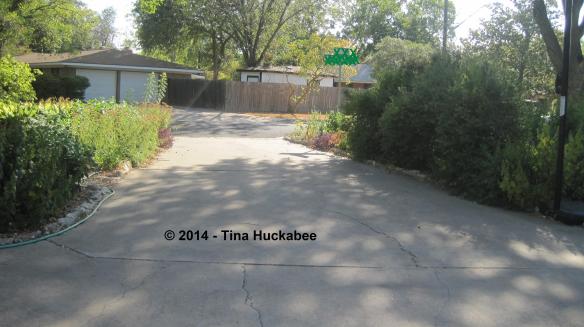


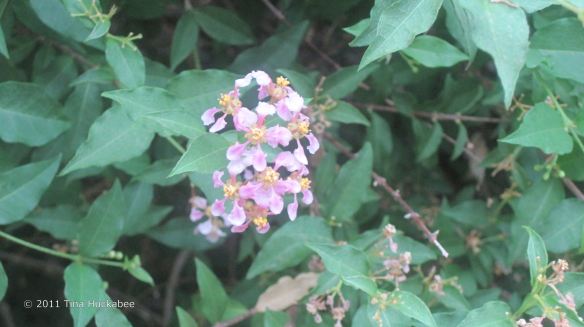

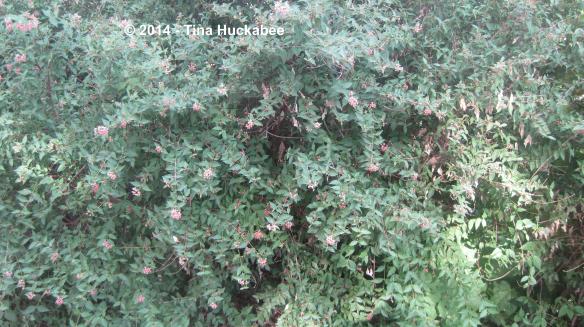
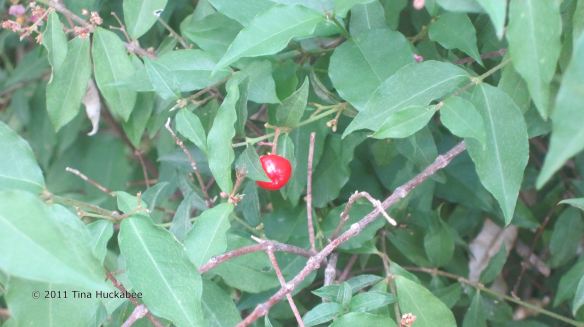

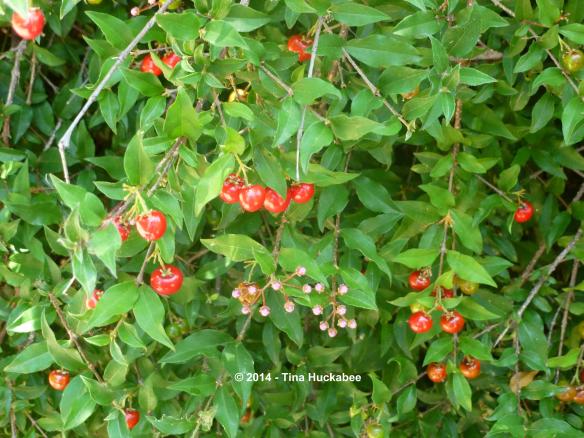
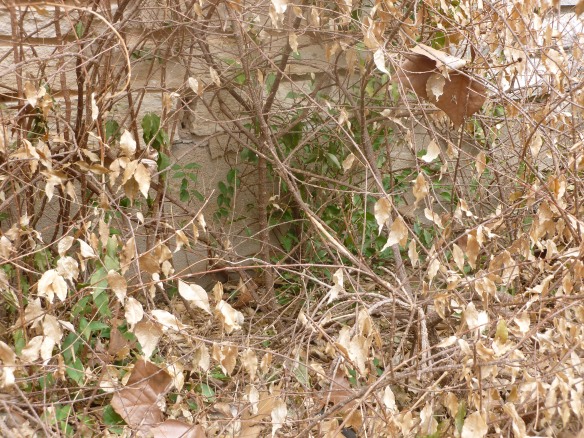


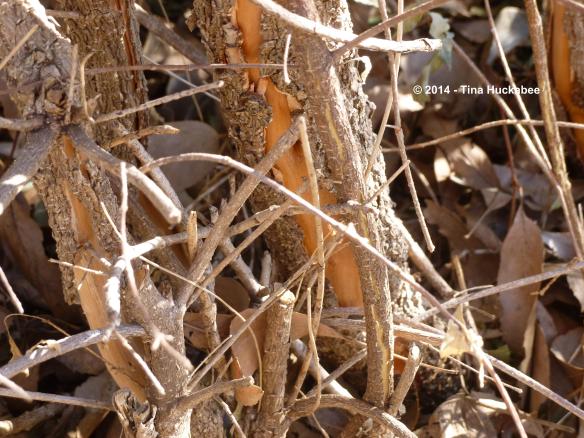


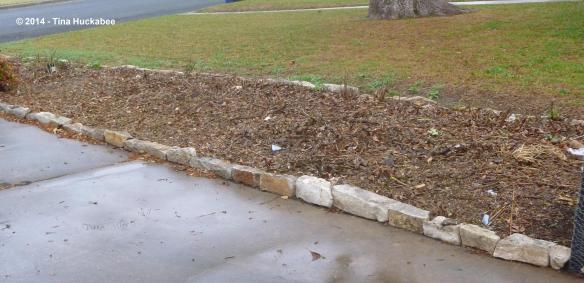
A Seasonal Look! What a great idea for beginning and experienced gardeners alike. I love the look of the Barbados Cherry but have too much deer traffic out front and too little room currently out back. I’m sorry for your freeze loss, but a little envious of the chance for a garden bed do-over. I really like your idea of diversifying that area and I’m eager to see followup shots as you put a variety of natives in. Fun!
LikeLike
I’m pleased that the B. Cherry are returning, slow though they may be. But I’m going to remove some of the plants that colonized out from the original shrubs. Good thing too, as my request for some agarita just came in from BSN and I have two sitting awaiting transplant into the (somewhat) reconfigured garden. Now, if I can just find some Globe mallow…. Fun indeed!!
LikeLike
I can’t wait to see them in play in your spaces. And mallow too! I am a mallow fan in every way.
LikeLike
No one has mallow right now, though I saw on the list of the Wildflower Center’s plant sale next week that they’ll have Sphaerlacea incana–now if I can make it out there before they run out!
LikeLike
Oh my, what a difference that made in the look of your hedge and front garden. Seasonal looks is a great idea. Hardier native plants will work well there too.
LikeLike
Hi Shirley! I’m looking forward to the marginal re-do–any excuse to garden, am I right?
LikeLike
A great idea but sorry the plant had to have the full gamut of looks this year. I am about to remove my Philippine Violet-after all those years of beauty I can hardly believe it. Fresh beginnings.
LikeLike
So sorry to hear that you’ve lost the Philippine Violet–it was such a beauty. You could plant another, understanding the weirdness of our weather. I’m pleased the Barbados Cherry is coming back, but its dying back has opened up new doors. Fresh beginnings, indeed.
LikeLike
I’ve only had my Barbados cherry plants for 3 years. I saw them in other gardens and assumed they were hardy here. Out of 4 plants I only see signs of life on one so far, so it looks like I will diversify as well.
LikeLike
Bummer about your B. Cherries, but you might give them a little more time. Interestingly, I’ve noticed that the newer parts of the “hedge,” the plants that rooted out from the mother plants, re-emerged more quickly and vigorously. Age slows all of us down, I guess.
LikeLike
Never a dull moment in the garden! I too like your idea of diversifying – it’s always fun to dream about the possibilities of what the new bed will develop into over time. My newly planted (last year) dwarf b cherry is showing no signs of life. I sure loved it for those little pink flowers…I was smitten for sure. It was planted on the coldest side of the house with no protection so maybe the conditions this winter were just too much but I haven’t given up hope just yet. After all, the firespike just started showing signs of life last week and it’s planted in the same bed. Fingers crossed!a
LikeLike
Hi Cat! Give your little B. Cherry a bit more time. Mine are still slow and they are in sun with reflective heat from the driveway. They are slow this year, but I bet it comes back–I hope so.
LikeLike
I’m still waiting (drumming fingers impatiently) for signs of life on my dwarf Barbados cherries. Everything is slow in coming back this year, so I’m still hopeful.
LikeLike
Keep hope alive! Poor Barbados Cherry, they really were dinged this winter. Mine are very slow, but all have returned. I hope yours return, but if they don’t, you can always plant more–of those or something else!
LikeLike
Talk about making lemonade out of lemons… you sure have a good attitude about this year’s losses, Tina! I was down to two Barbados cherries last year, one was 7-yrs old, the other 10-yrs old. Now mine look like yours, the tops died but it looks as if there is some life at the base of both.
Good luck finding the globe mallow!
Annie at the Transplantable Rose
LikeLike
Hi Annie! Well, I can moan and groan about them, but that’s not going to help much, is it? I’m glad yours are returning, mine are just soooo slow. It’s been nice being able to plant other things in that garden and change it up a bit. That’s what we love, isn’t it? It’s annoying about the globe mallow as that’s one of the plants I want to add to the garden. The Wildflower Center had the true Texas native, S. incana on sale last weekend (according to their plant list), but I just couldn’t make it out there. Eventually, someone will have the ambigua. Hopefully!
LikeLike
Pingback: A Refurbished Garden | My Gardener Says…
Pingback: The Spring Garden | My Gardener Says…
Pingback: Native Season | My Gardener Says…
Thank you for providing details about freezing temperatures. This past January we had some serious cold. I also appreciate the photos, so I know how to gauge how frozen my tree got.
LikeLike
You’re very welcome!
LikeLike
Pingback: June Pollinator Blooms | My Gardener Says…
Pingback: Breakfast Buddies? | My Gardener Says…
Gee but I wish that I lived at least 100 miles south. I would love to grow B cherry but I see now why I have never seen it in the nurseries here. It is pretty and useful as well. I admire your energy. If I only I were 10 years younger. I can do very little in my yard since the afib problem but I can prune light stuff a bit and water and other light chores. I find it wonderful that you have two yards where you can indulge your passion for nature;
The red tailed hawk pics are not bad at all. When ever a hawk shows up in my hood, the crows drive it away but none the less the Cooper’s hawk seem hell bent on being around most of the time.
LikeLike
I am sorry about your health issues, I’m sure that’s frustrating. But, it’s good you can get outdoors some and I’m sure you enjoy and benefit from that.
You might just try B. cherry sometime, our winters aren’t nearly as cold as they once were. 😦 I first became acquainted with this plant on a visit to my hometown, Corpus, and saw it in a park filled with native plants. I love B. cherry and it’s such a good wildlife plant.
Funny that you’re red-tails aren’t as ornery as the Cooper’s. We also have a Cooper’s around; I’ve mostly seen it hunting from my back garden, though no pics so far this year.
LikeLiked by 1 person
Thank you. I should make I clear that I don’t see the red tail very often- none for several years and that those might have been migratory. But I do have Barred owls and, on occasion, I hear a Great Horned but it has been about two years since I heard a Great Horned call. I used to have a nesting box for screech owls and they managed to raise young two times. Then the squirrels took over and I just had no way to keep the squirrels out of the box, so I took it down. For one thing predators fight for territory and available food supply. And seldom are there more than one kind of the same species. I read that but don’t know that as a fact but it does make sense. Actually I prefer Barred owls rather than the Greats who are too powerful and greedy. I have neighbors that insist on letting their cats roam at will so they are easy prey for the larger owls if the cat is on the small side. I know that I am getting off topic here but I love birds. I stopped feeding the birds because the Coopers had easy hunting as they stalked my bird feeders. I miss the birds a lot at the feeders very much but I just could not provide the hawks with easy prey.
I might try the B. cherry. I sort of have little micro climates on my one acre. I have seen Tropical sage blooming in a few spots. Nothing to brag about-the blooms are tiny but no the less they bloomed.
LikeLike
I hope you do try B. cherry–I think you’d like it and your smaller songbirds would definitely like it. Let me know if you find some and plant, I’d be interested in how it does for you.
LikeLiked by 1 person
Pingback: Symmetry | My Gardener Says…
Pingback: September Blooms | My Gardener Says…
Pingback: Autumn Natives | My Gardener Says…
Thanks for the pictures of Barbados Cherry freeze damage. This morning I found that mine had succumbed to the great Austin Valentine’s freeze of 2021. Seeing the stems burst apart with ice reminded me of frostweed a bit. And we haven’t even gotten to the really cold part of this freeze yet! Gardening in Austin is always a learning experience. 🙂
LikeLike
Hi Deborah! Yes, lots of plants will do that icy stem explosion thing, Barbados Cherry included. Ugh, you’re right: the bad hasn’t even started yet. Best guess is that the BC will need pruning to the roots, but it’ll come back. It will be very interesting to see how things fare after this is over. Gardening in Austin is a trip! Stay warm!!
LikeLike
Pingback: More than a Dab | My Gardener Says…
My Barbados chery tree has a split in the bark. The bark is white no fungus noted. I have no blooms, I live in Texas.Any suggestions.
LikeLike
If your Barbados cherry is anything like mine, it froze to the ground completely and needs pruning back. Mine is just beginning to send up new foliage from the roots. These shrubs come back quickly, but they’ll be tidier if the old growth is gone, making way for the new.
LikeLike